[ad_1]
Yinka Ilori‘s bold, colourful style can be seen all over London this summer, but the designer tells Dezeen there’s a lot more to him than bright graphics.
London-based Ilori, 32, made a name for himself with his characterful chairs, which he creates by upcycling various pieces of unwanted old furniture, and adding colours and textiles that reference his Nigerian heritage.
However the designer recently collaborated with architects on two large-scale projects – a summer pavilion in Dulwich and the transformation of a gloomy underpass in Battersea – and also created the exhibition design for Somerset House show Get Up, Stand Up Now.
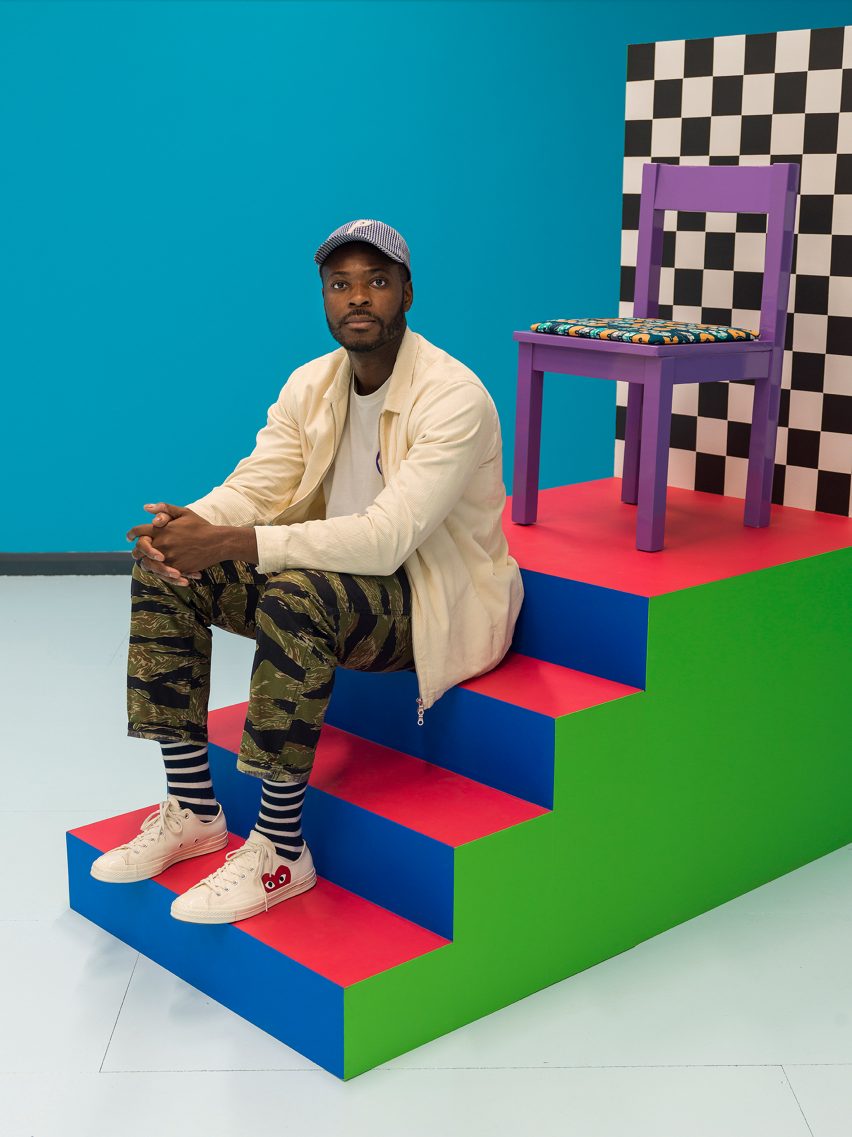
Speaking to Dezeen at his studio in Harrow, Ilori said these new projects have brought him a lot of attention, but that he has to be careful that people understand he is a designer, not just a colourist.
“That is my real worry,” he said. “I don’t want to be seen as someone who’s just a colourist, the guy who just slaps a bit of colour on and that’s all he does.”
“I love graphic design, but I’m not a graphic designer,” he continued. “No offence to anyone, but it’s not my passion, my passion is design.”
Giving old objects a new narrative
Ilori is from north London, but both of his parents are Nigerian. In his work, he aims to fuse together the traditions of British design with the loudness of Nigerian culture. But he also wants to give every design a story, in the spirit of the parables his parents told him growing up.
“Our parents always told us stories about things like jealousy, love and respect,” the designer explained. “These were, for me, really important in my growth and upbringing. I always wanted to try to share their stories in my objects.”
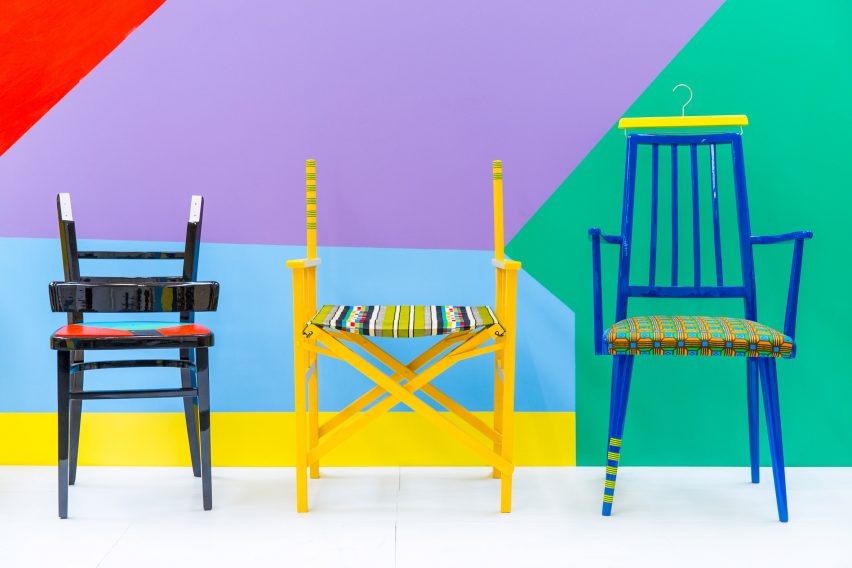
Ilori created his first furniture collection in 2013 with a £3,500 grant from the Prince’s Trust. His breakthrough came two years later with the London Design Festival exhibition If Chairs Could Talk, featuring designs with names likes Captain Hook, Flower Bomb and A Trapped Star.
“I wanted to try to use old objects and give them a new narrative, but one that wasn’t so serious,” Ilori told Dezeen.
“I was very much obsessed with how objects can tell stories. We just see chairs as chairs, but we do so much on chairs – we cry, we argue, we fight – there’s so much.”
“Colour isn’t the first thing I think of”
The designer unveiled his biggest project to date in June this year. Designed in collaboration with architecture studio Pricegore, The Colour Palace is a multicoloured pavilion built to host a programme of events for the London Festival of Architecture and Dulwich Picture Gallery.
The cube-shaped structure features a facade made from thousands of hand-painted pieces of timber, displaying a pattern referencing the traditional African textiles that can be found in the markets of nearby Peckham.
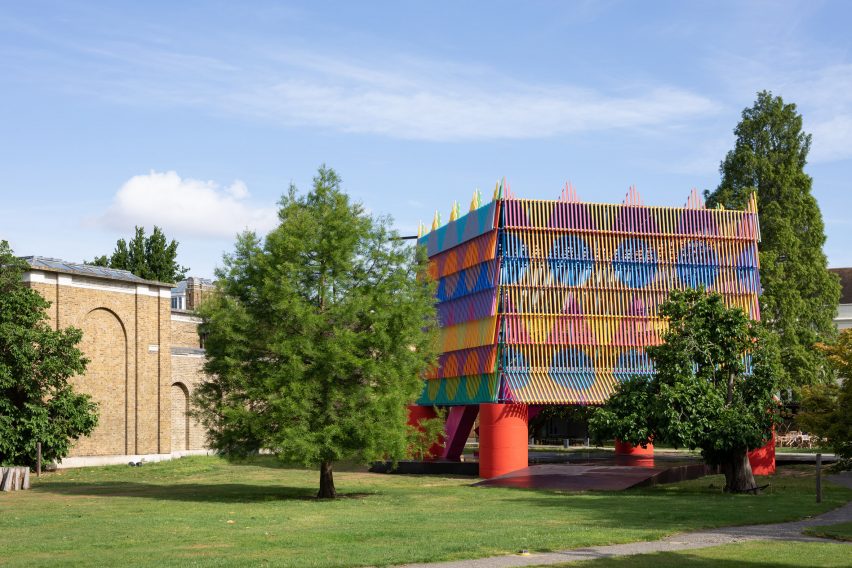
Ilori says the pavilion is the best thing he’s ever done, but is worried that people think his only role was to design the exterior finish. He says he has since had to turn down commissions where a client has asked him to just apply colour to a finished design.
“I’ve seen a few comments from people about the pavilion on social media saying: ‘Pavilion designed by Pricegore, colour by Yinka’. I did a bit more than that!” he said.
“Yes, I can use colour but I don’t just do that,” he added. “I’m a designer, I design objects and spaces. Colour isn’t the first thing I think of, it works together with a design.”
Designs that create feelings and memories
For Get Up, Stand Up Now, an exhibition celebrating 50 years of black creativity in the UK, Ilori worked with curator Zac Ové to create a series of spaces where colour is used to incite different emotional responses.
His latest project, Happy Street, uses colour and pattern to make the space under an old railway bridge more welcoming.
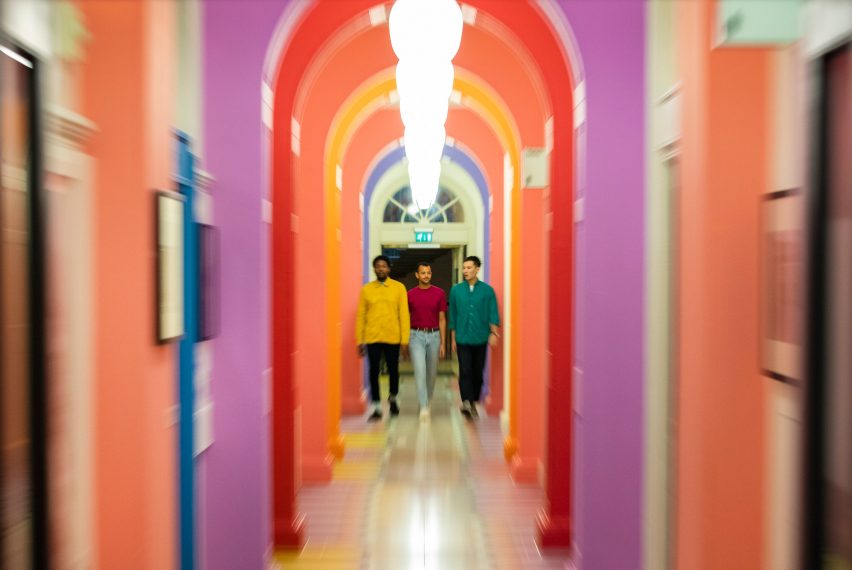
“Design for me personally is about trying to evoke a feeling and create a memory of something, so it lives and you can pass it on,” said Ilori.
“As designers, we have such power to make design change the world. We really need to make better use of our platform and do stuff that is useful.”
Read the edited interview in full below:
Amy Frearson: How did you end up becoming a designer?
Yinka Ilori: When I was in primary school, we had an art class once a week and I remember painting this watercolour, this kind of desert landscape. And remember being really obsessed with this painting. So as a kid I fell in love with art.
Then in secondary school I had a teacher who was really supportive of my painting and said I should consider doing art as a degree, but my fear was that artists don’t make any money. So I wasn’t going to go and do a degree in Fine Art – my parents wouldn’t really approve. But I also loved Design and Technology as much as I loved art and I thought I could do both.
So then I went on to do my A levels and I did Fine Art, Sociology and English Language, then after that, before I went to university, I did a BTEC art and design course. There I discovered I was more into making stuff, making objects, and that’s how I started designing furniture.
Amy Frearson: What were the first projects you worked on after you finished university?
Yinka Ilori: I did an internship for Lee Broom for two or three months. He was actually the first person I emailed about doing an internship because I loved the work he did early on in his career. It was furniture but it was also quite sculptural, like art and design put together.
I couldn’t really see myself or my culture in my work
At the time he was doing a project at Westfield, a restaurant called Mandaloun. When I went in there it was empty space, literally just a blank canvas. So I got a real insight into how to start a project and how to breathe life in to make it work.
But then I also felt a bit confused, because I couldn’t really see myself or my culture in my work, I couldn’t see anything that represented me, you know? So I took a step back and decided to do it myself.
I got a loan from the Prince’s Trust of £3,500 and I made my first furniture collection from that. And then I had my first exhibition during LDF at the OXO Tower. It was 2013 and my first ever show after leaving university, off my own back, which was very scary, because you don’t get taught a lot of things at uni, like marketing, the business side of things. So that was tough, that first move into the big, wide world of design.
Amy Frearson: How did you bring yourself and your culture into your designs?
Yinka Ilori: My parents are both from Nigeria. They lived there for about 40 years. But then they came over here to give us an opportunity to experience life differently from how they experienced it, which I am always grateful for, because I know I could never leave somewhere like they did. They left everyone, they left their good jobs. They had quite a good life, so to then come over here and start from scratch is bonkers.
I first went to Nigeria when I was about 11. Then I went again when I was at uni, and again after I’d I finished uni. It’s amazing, there’s so much culture there. It’s such an energetic country and Lagos is so busy, full of culture and colours that I love. I wanted to tell the narratives of those experiences, but whenever I’d come back to London I’d feel like there was so much difference in culture. I loved both cultures, they were just so different. So I remember being at home and feeling like I was Nigerian, and then going out into the public and feeling I had to be British, be a different kind of person. It was like living two lives.
So I thought the best way for me was to try to incorporate the kind of minimalism that is British design and the Scandinavian design that I love, and then infuse it with patterns, textures and colours that are very loud. Nigerians are very loud, it’s very much a culture that wants to be visible. That’s what I wanted to bring into objects and that was how I started designing chairs.
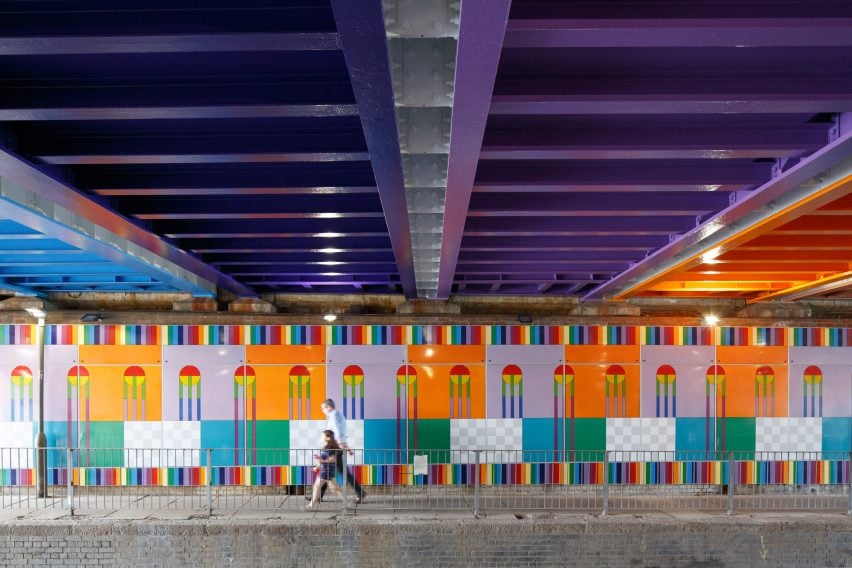
Amy Frearson: Can you tell me about your first collection? How did you combine these contrasting cultural influences?
Yinka Ilori: Have you ever seen a Nigerian movie? Most Nigerian movies are about things like love, or black magic – yeah it’s bonkers – but there’s always a meaning behind them, they’re always trying to teach you something. In the same way, our parents always told us stories about things like jealousy, love and respect. These were, for me, really important in my growth and upbringing. I always wanted to try to share their stories in my objects.
I designed my first collection in my back garden in Archway with some tools my dad bought for me from B&Q, where he was the store manager. He bought me a saw, a chisel set and a table saw. And we did it on my garden table, which is bonkers.
I did a chair called ThreesAcrowd, one called Kekere and another one which is called Let there be Light. And those chairs were just based on those parables that my parents told me about love and space and hierarchies.
The first thing you do when you see my chairs is smile
I was very much obsessed with how objects can tell stories. We just see chairs as chairs, but we do so much on chairs – we cry, we argue, we fight – there’s so much. I wanted to try to use old objects and give them a new narrative, but one that wasn’t so serious.
The first thing you do when you see my chairs is smile. But then when you read the narrative, there is a message behind that you can use in your life or that makes you feel somehow connected to the object.
Amy Frearson: Do you only work with recycled pieces when you’re creating furniture?
Yinka Ilori: What I try to do is incorporate two chairs into one and take elements from two objects or maybe three. I try to mix and match.
This whole idea of kind of up-cycling and reviving furniture started with a project I did at university inspired by Martino Gamper and his project 100 Chairs in 100 Days. I loved it so much I continued it on and that was how I started to design furniture.
Amy Frearson: What about the furniture workshops you did with community groups? What made you start doing those?
Yinka Ilori: Beatrice Galilee had this project she was doing at Milan design week with La Rinascente. I was working in Marks and Spencer at the time, but I got an email from Beatrice saying: “Hi Yinka, we’re doing a project in Milan and we want you to design some chairs for the restaurant”.
But it was quite a lot of chairs, like 20 or 30. I couldn’t do it, I didn’t have the resources. So she suggested I do a workshop and it started from there.
What happens is you come into my studio and you bring a chair that you’ve found, but the chair should have a meaning behind it. Then you choose a parable, something like “one should not throw stones at a bird that wants to fly away” or “no matter how long a giraffe’s neck is, it still can’t see the future”. They’re funny, but meaningful if you dig deep.
Then you have to somehow translate the parable into the object and it becomes quite a sculptural piece. And we’d have afro beats soundtracks in the background and live music by a talking drummer, who comes around to you and mimics your parable back to you, which might inspire you to create something amazing.
Amy Frearson: What made you decide to move into bigger projects and installations after that? Was it a conscious decision to go bigger?
Yinka Ilori: The honest truth is that I have always been given spaces by people. “Here’s a space for you. Do what you want.” And I always think fuck, what am I going to do? I can’t just put a chair in there! So I feel like I was forced to think big.
Amy Frearson: What was the first big installation or exhibition you worked on?
Yinka Ilori: The first big one would have to be If Chairs Could Talk. That was in 2015, when I was almost going to give up design, because it just wasn’t working out for me. I wasn’t getting any press at all and I felt like I was just talking to myself, you know? I was just like, I’m done.
But that got picked up and it went everywhere. It was amazing, also because that show for me was very personal. It was about five people I grew up with in my school in north London, and it told their story. The people that the chairs are about didn’t know it was about them, I never told them, but they’ve seen the show. So that was big for me in terms of emotion and in terms of quality.
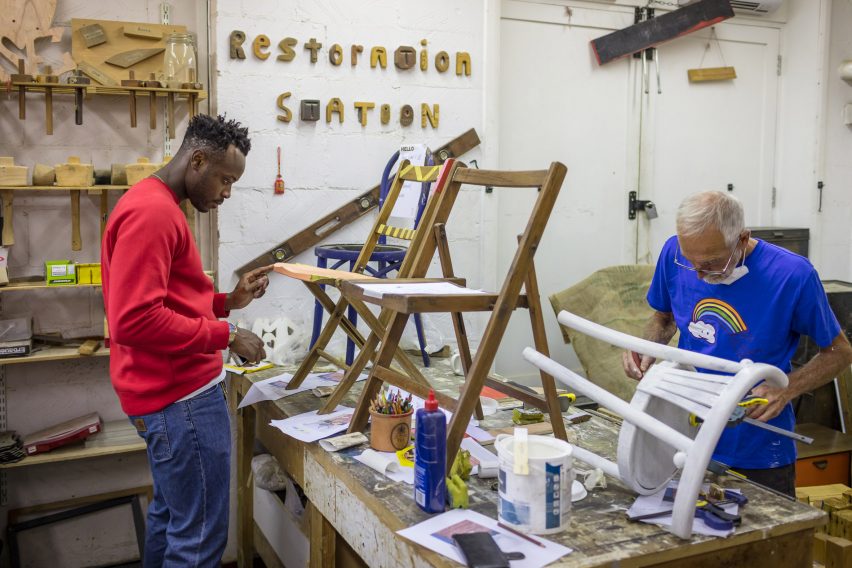
Amy Frearson: Is there an element of storytelling in every project you work on?
Yinka Ilori: Yeah, I think because in our house storytelling was such a big thing. Dad always told stories about his childhood and maybe some of the stories were a load of bollocks, but we listened and sometimes we would retell those stories to our friends.
For me, culture is such a big part of London. Where I grew up in north London, we had every culture there: people from Somalia, people from Eritrea, people from Poland, people from Brazil. We had every kind of culture and that was amazing.
So I wanted to keep that cultural integrity in my work and those stories, to keep retelling them, because I’m sharing my journey and some of me. I feel like objects should do that.
I feel like design objects now, some don’t do that. Some I feel like are just pointless design. As designers, we have such power to make design change the world. We really need to make better use of our platform and do stuff that is useful. There is loads of great design out there that I just feel like sometimes I want to ask: What is design? Is it making someone feel better or happy? What is it?
Amy Frearson: Do you think design is about making people happy?
Yinka Ilori: Design for me personally is about trying to evoke a feeling and create a memory of something, so it lives and you can pass it on.
Amy Frearson: Now that you’re getting more well-known and getting more commissions, do you ever worry about being typecast as the guy that does colour?
Yinka Ilori: That’s a great question. It’s a good one because I love colour, you know, it always will be in my DNA. But the issue is that sometimes, since doing the Dulwich Pavilion, people have come to me and said: “We’ve got this building, can you apply colour to it?”
I don’t find colour hard to use, it comes very naturally to me
It pisses me off a little bit. Yes, I can use colour but I don’t just do that. I’m a designer, I design objects and spaces. Colour isn’t the first thing I think of, it works together with a design.
But then the reason why they can’t apply colour is because it’s hard. They can’t do it. I don’t find colour hard to use, it comes very naturally to me. But architects or developers, for example, they can’t use colour. So they struggle. Maybe it’s just the way they word it: “Can you just stick a bit of colour on there?”
So yeah, that is my real worry. I have said no to some work based on that. I don’t want to be seen as someone who’s just a colourist, the guy who just slaps a bit of colour on and that’s all he does. I’ve seen a few comments from people about the pavilion on social media saying: “Pavilion designed by Pricegore, colour by Yinka”. I did a bit more than that!
I think when brands come to me about doing projects, I’ve got to be quite careful. For example, I got an email from a stationery company that does gift wrap, and birthday cards, that kind of thing, saying they wanted to license my designs. I had to say no, sorry, that’s not what I do. I love graphic design, but I’m not a graphic designer. No offence to anyone, but it’s not my passion, my passion is design. So I don’t want to be pigeonholed as someone who just paints and applies colour.
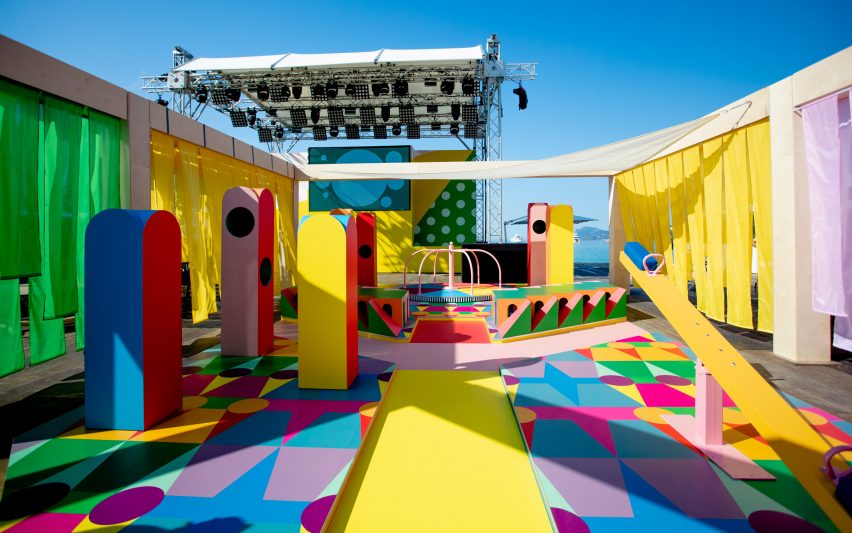
Amy Frearson: How did you find working on the Dulwich Pavilion?
Yinka Ilori: I learnt a lot about things, about engineering for example. Because it’s so easy to design something but not know how it’s going to be put up. I also learnt how to be patient.
With furniture, I can make a chair in a day or two days. Whereas architecture could take a year, two years, three, four, five or 10. And you could be told it’s not going to happen anymore. That for me is tough. Trying to understand and respect other people’s ideas, and trying to come together to find a neutral ground can be quite hard too.
But one of the best things I’ve ever done is the pavilion. It’s opened doors for me to do other things and I know now that I can do a pavilion.
Amy Frearson: Do you have a particular method for developing colour palettes for your designs?
Yinka Ilori: A good example would be the exhibition at Somerset House. It was a tough project because it made me dig deep and really explore colours to a different level. Because you couldn’t display any colours in this exhibition, it had to be part of the themes.
That’s powerful, how colour makes you feel a certain way
We had to work out which colours best represented each of the five themes, so there was lots of creating mood boards and testing colours in the spaces. When you walk into the space, how does it make you feel? I think everyone has at least one colour that they have an attachment to, that maybe evokes a memory, negative or positive. That’s powerful, how colour makes you feel a certain way.
There is always a different colour palettes for different projects, but I do have a very consistent palette: pink, lilac, orange, yellow.
Amy Frearson: What other things have you got coming up? Do you know what you want to do next?
Yinka Ilori: I would love to do another pavilion. That would be amazing. I also want to design a hotel.
Amy Frearson: Why a hotel?
Yinka Ilori: Because that’s a space that I feel like I can explore with colour. I could really play with people’s taste of colour, emotions and feelings, and curate furniture to create spaces that set different moods. Maybe next year, you know?
[ad_2]
READ SOURCE


